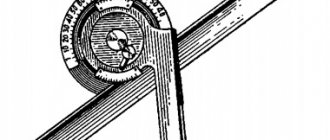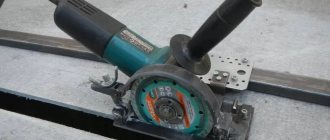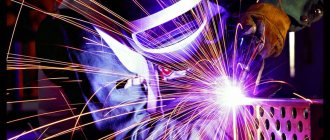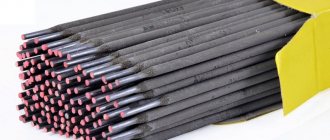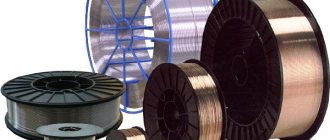The essence of the gas-flame surfacing process
[context] Surfacing is used primarily for repairing and restoring worn-out parts, as well as for applying surface layers with special properties.
The process is similar in many ways to gas welding. Unlike welding, the surface of the parts is melted to a lesser depth. Using a gas burner, you can control the degree of melting of the filler and base metal independently of each other. The burner flame protects the molten metal from oxidation by air and evaporation of chemical elements. To apply the deposited layer, it is necessary to heat the base metal. A flame is directed onto the heated metal, but not melted, and an additive is added. The molten additive should spread over the heated metal.
The disadvantage of gas-flame surfacing is low productivity depending on arc surfacing methods and a large heating zone. A large heating zone for parts increases the likelihood of stress and deformation, so this type of surfacing is best used for small parts.
Equipment for mechanized surfacing
Usually these are installations, the “heart” of each of which is a converted lathe: instead of a tool holder, it has a head, it is also equipped with a power source and often a reduction gear that reduces the rotation to 5 or even 2 rpm.
Although there is a technique for crankshafts that does not require additional modification. These are machines like OKS-5523 with universal centrifuges, and they regulate the speed steplessly.
Current sources can be connected to a variety of sources, for example, it could be:
- • rectifier from the VKS-500-1 or VS-600 series;
- • converter like PSU-500-2 or PSG-500.
When choosing heads for supplying additives, preference is traditionally given to models from the OKS family.
The most common electrode is considered to be a spring wire with a cross-section of 1.6-2 mm, although the Sv and Np series are also popular, including low-carbon and high-alloy ones. You need to select one of them so that the applied coating is similar in its chemical composition to the base one.
Flux is a mixture of powdered graphite with ferrochrome and liquid glass. These substances are mixed in certain proportions and calcined, then allowed to brew, and then added to the clean and already prepared one. Then all that remains is to store it in a dry container and use it as needed.
Gas-flame surfacing of non-ferrous metals
The gas flame method directs brass. For surfacing copper and bronze, it is advisable to use arc surfacing methods. Brass is used for steel and cast iron parts. The flammable gas may be acetylene and its substitutes. The latter are used for surfacing silicon brass using fluxes.
To avoid cracking, the gas flame must be normal. Depending on the height of the deposited layer that needs to be obtained, the torch tip and the diameter of the filler wire are selected.
See the modes of gas-flame surfacing in the figure below.
Materials for flame surfacing of brass
Filler wire . The vast majority of brass additives are suitable for surfacing brass on ferrous metals, except for those made of silicon brass (LK62-05, LK80-3, etc.). Silicon brass creates a porous layer at the fusion site and does not provide a reliable connection with the ferrous metal.
Brass grades LK62–02, with a low silicon content, and LNK56-03-6, alloyed with nickel, are well suited.
Fluxes . Surfacing of metal with simple brass is carried out using gaseous fluxes BM-1 or any other fluxes used for welding brass. Flux is injected directly into the flame, which is why the process is called gas-flux surfacing. Silicon brasses are fused using flux paste No. 3. Flux is introduced into the molten metal manually (except for gaseous ones).
Technique of flame surfacing of brass
The surface of the surfaced parts is prepared for surfacing - cleaned to a metallic shine. The surface of the filler wire is cleaned of dirt and oxide. Large parts must be heated to a temperature of 500 degrees. When using powdered fluxes, parts are heated to 900-950° C. They are used more often for surfacing brass on steel and cast iron.
Surfacing is carried out using the left method, in the lower position. For surfacing surfaces of different lengths, surfacing can be carried out using continuous or inversely stepped beads. In the latter case, each subsequent roller should overlap the end of the previous one by 15-20 mm.
Surfacing can be single or multilayer. After applying the flux, the first layer is made 0.3-0.5 mm high. The last layer is made based on the required height of the roller. The torch is inclined at an angle of 45° to the base metal.
During surfacing with straight layers, the part can be tilted at an angle of up to 15° to increase the height of the deposited layer. When surfacing circumferential welds, the angle of inclination should not exceed 40°. To avoid zinc evaporation, a carburized flame must be used. After surfacing, the seams are forged at a temperature of 750-800° C.
Surfacing of brass onto cast iron should only be done in extreme cases. Heating cast iron to a temperature of 900-950 degrees leads to burnout of graphite, the combustion products of which are difficult to wet. Therefore, it is necessary to immediately burn out the graphite from the surface layers of cast iron with a carburized flame and clean it with a brush.
What is called mechanized surfacing?
In general, this is the process of applying a special layer to a worn surface, which, once hardened, will not only restore the original shape of the part, but will also become a kind of protective coating. The whole point (and the main feature) here is how this type of work is carried out, and it can be implemented in one of two options:
- • automatically – both the supply of electrode material and its movement (and workpieces too) in space are performed by equipment; many installations also provide transverse vibrations of the guided rod, which reduces the number of passes;
- • semi-automatically – mechanically, only the wire (or other additive) is delivered to the work area through a hose, after which the welder independently moves the holder with it relative to the workpiece.
Each has its own characteristics. So, in the first case, there may not be enough flexibility in positioning; in the second, much depends on the skill of the person solving the problem. Although labor productivity in both situations is much higher than with any of the manual methods (they have other advantages). The quality and uniformity of the coating are usually also better, which determines the breadth of application, especially in serial applications.
Gas welding of medium carbon and high carbon steel
The main difficulties in welding
- The weld pool boils.
- The metal is hardened in the weld zone, and cracks form in the weld and heat-affected zone (HZZ).
Welding Features
- The torch power for welding is selected slightly less than when welding low-carbon steel.
- It is recommended to use flux, especially for welding high-carbon steel (50% NaCO3, 50% Na2CO3).
- It is recommended to anneal the workpieces before welding.
- Welding should be performed with general preheating of the product; overheating and boiling of the weld pool are not allowed.
- After welding, it is necessary to ensure the slowest cooling of the welded joint (covering with sand, asbestos).
- In all cases of welding medium and high carbon steel, subsequent heat treatment in the form of annealing, normalizing or hardening with high tempering is recommended.
Welding patches
When installing patches, it is necessary that the patch material matches the base metal in thickness and steel grade; The corners of the hole and patch must be rounded, since when welding patches with sharp corners, cracks appear starting from the corners.
The required bevel of the edges is made in the base metal and in the patch. The size of the patch is taken such as to obtain the appropriate gap.
The edges are cleaned of rust and dirt. After fitting, the patch is secured with tacks every 200...250 mm. Welding is carried out in the order shown in Fig. 7. The patch is given a convex shape. During welding, such a patch will be freely deformed. After welding, the heated patch is straightened with hammer blows. This prevents the formation of shrinkage cracks when the weld metal cools.
Rice. 7. Scheme for welding patches
Metal surfacing methods
The surfacing method should be as simple, fast and safe as possible to implement, and also prevent metal deformation. Let's look at the main methods, the most common.
1. Electric arc.
For it, classic electric arc equipment is most often used. It can be manual or mechanized. The first option involves the use of conventional DC inverters and rectifiers, in which the plus is connected to the electrode, and the minus to the product itself. This simple assembly reduces the level of overall heating and melts the base layer shallowly. If you add a special additive mixture, you can evenly increase the surface strength.
Mechanized surfacing is carried out using semi-automatic welding machines with solid or flux-cored wire. The main advantages of this method are a high level of productivity and joint quality. If you first sand and clean the area, the seam will be perfectly smooth.
2. Vibro-arc.
This method is used to work with non-ferrous metals up to 1 mm thick and with virtually no heating of the top layer of the product. During the procedure, the electrode moves with an amplitude of 0.3-3 mm and a frequency of up to 100 Hz. As a result, an arc is created for one-fifth of the total time and a small amount of metal is exposed to the surface. The depth and thermal impact on the part are minimal.
For vibratory arc surfacing, semi-automatic machines with special electromechanical devices with intermittent wire feed (1.6-2 mm) are used. The procedure must be carried out in a safe environment consisting of gas, solution or foam that is safe for health.
3. Gas flame.
This method is considered the simplest and most accessible. Acetylene or propane-butane mixture is used as a heat source; as an additive - rods or wire; for fluxes - a mixture of boric acid or borax.
Small parts are welded immediately, and large parts are first heated to a temperature of 500 degrees. Powders can be used as useful additives; they can be introduced into a flame stream, which can settle on the surface in small drops.
For gas-flame fusing, plasmatrons are required - special welding machines equipped with a powerful torch. Additives are supplied only in an automated manner, as this is unsafe for humans. Not only powders, but also granules can be used as additives.
The advantages of the method are shallow welding and a uniform structure of the joint layer. The disadvantage is the high cost of the method and heating the plasma to high temperatures.
4. Plasma.
It is performed on special devices equipped with a gas burner. A flow is formed in it, reaching a temperature of several tens of thousands of degrees. Powder or granular mixtures can also be used as additives.
5. Electroslag.
This thermal process uses a slag bath - a container with a catalyst, which moves along the workpiece. An electrode or additive in the form of a granular composition is placed in this vessel. Then the temperature is increased under flux and slag. In this case, the materials become a kind of protective shield that protects the work area from harmful gas effects.
The slag bath is located vertically: thus, air bubbles do not have time to form pores and do not float up. As a result, there is no heat loss or splashing. The advantage of this method is that it is an affordable option. But the disadvantage is labor intensity and the inability to work with small-sized parts and complex configurations.
6. Laser.
Flux or powder is used as an additive; they are melted using a focused laser beam. The laser is emitted from a special head using a nozzle (heats the gas flow) or an injector (injects a useful additive).
The method allows you to ensure the most accurate result and stable quality coating. The method is used only in very critical cases, as it is the most expensive to use.
7. Induction.
The principle of the method is to melt the filler material and the upper metal layer using vortex flows that are induced on the surface. To do this, a flux additive is applied to the product area. Then an inductor made of several turns of a tube with high-precision voltage is located above it.
The depth of deposition depends on the frequency of the inductor current: the higher it is, the lower the depth. This method is considered the most productive and provides minimal heating of the metal.
8. Electric spark.
The procedure is carried out using short-term current discharges and the application of an ultra-thin coating. Surfacing is carried out using a special installation. The electrode must be set to the plus sign, and the workpiece to the minus sign. When current discharges, the particles are torn out and welded into a dense, finely porous seam.
The method is considered affordable and convenient, due to the almost complete absence of surface heating. No oxidation or deformation is observed during the procedure. Thus, the product receives a long service life.
Welding high-alloy and tool steel
The main difficulties in welding
- Cracks form in welds due to the strong hardening of the metal in air.
- The result is seams with great chemical heterogeneity.
Welding Features
- Before welding, workpieces must be in an annealed state and thoroughly cleaned.
- Before welding, workpieces must be heated to a temperature of 250...300 °C.
- When welding, flux must be used.
- The flame should have a slight excess of acetylene.
- After welding, the hot products must be placed in an annealing oven.
In addition to various steels, the flame of a gas torch can weld cast iron, copper, brass, and bronze. Gas flames are widely used in repair welding of cast iron, for surfacing, and also for soldering various metals. The gas flame can provide the process of separating metals or oxy-fuel cutting.
Alloy steel welding
Main difficulties
- The metal is hardened, and the more carbon and alloying additives there are in the steel, the more cracks and cracks form in the weld.
- Burnout of alloying elements from the molten metal occurs.
Welding Features
- It is necessary to gradually heat the metal at the start of the seam.
- Sutures should be applied as quickly as possible, avoiding overheating of the metal.
- At the end of the seam, slowly, gradually remove the flame, forming reinforcement at the end of the seam, as well as heating the increased area of the metal.
- Avoid welding metal at low temperatures. Ensure slow cooling of the welded joint.
- Before welding, the workpieces must be in an annealed state.
